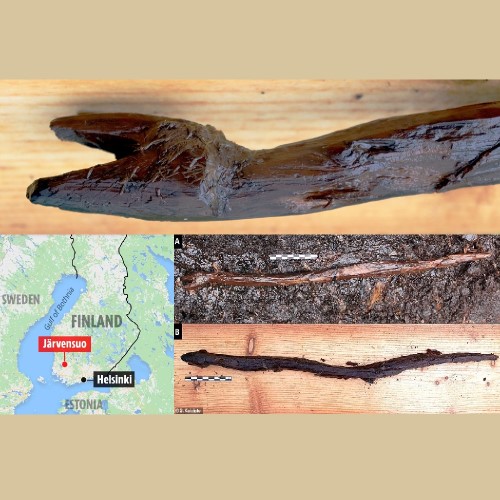Archaeologists discover a wooden snake from 2400 BC in Finland

A delicately carved wooden snake figurine was discovered in Finland in a horizontal position in peat overlying gyttja at a depth of approximately 0.6 m. Here the peat consists of a distinct bed of moderately decomposed sedge (Carex) and reed (Phragmites), indicating lush water meadow vegetation at the time of deposition. The figurine was lying on its right side, either having been lost, discarded or intentionally deposited amidst the thick lakeshore vegetation[1].
The figurine is 0.53 m long and 25–30 mm thick and it has been carved from a single piece of wood, its surface being completely worked with no ornamentation. The neck is narrowed and the slender body is formed by two carved bends continuing to the tapering tail. The flat angular head is portrayed in a slightly raised position with an open mouth. The figurine is very naturalistic and resembles a grass snake (Natrix natrix) or a European adder (Vipera berus) in the act of slithering or swimming away. The direct radiocarbon date of the artefact yielded a Late Neolithic date of 3908±32 BP (Ua-67655: 2471 BC – 2291 BC at 95.4%.
Corded Ware Culture connection
The fact that two ancient Latvian Hunter-Gatherer Y chromosomes have been characterized as belonging to the R1b-M269 clade suggests that both subclades of R1 were present in the Baltic area before the expansion of the Corded Ware Culture (CWC). All four of the Estonian CWC individuals could be assigned to the R1a-Z645 subclade of hg R1a-M417, which, together with N, is one of the most common Y chromosome hgs in present-day Estonians (33%). Importantly, this R1a lineage is only distantly related to the R1a5 lineage that we found in the CCC sample.
The finding of high frequency of R1a-M417 in Estonian CWC samples is consistent with the observations made for other Corded Ware and Sintashta Culture sites while the remains associated with the Yamnaya Culture, which is considered to be ancestral to CWC, have been found with predominantly R1b-Z2105 and no R1a lineages. The fact that all four of the CWC male individuals from two distinct sites in Estonia belonged to this recently expanded R1a branch, different from the one carried by CCC, suggests that admixture between CWC farmers and CCC Hunter-Gatherers may have been limited at least in the male lineages during the early stages of farming in Estonia.
Created on the 30th of June 2021
